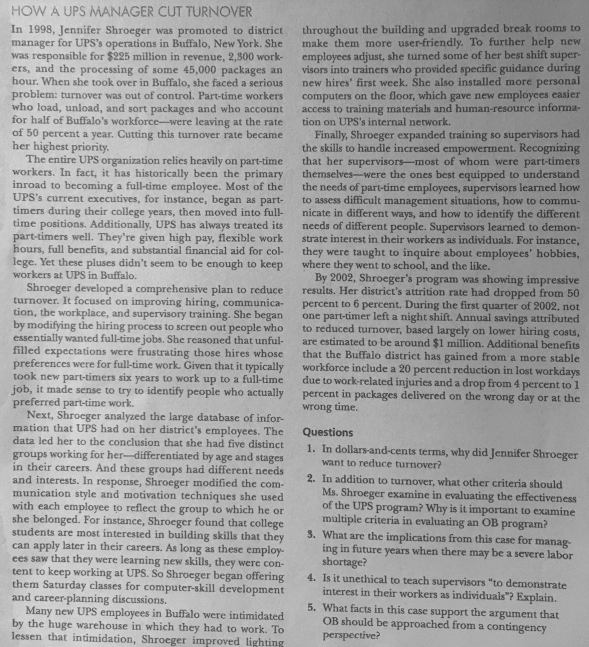
HOW UPS MANAGER CUT TURNOVER In 1998, Jennifer Shroeger was promoted to district manager for UPS's operations in Buffalo, New York. She was responsible for $225 million in revenue, 2,500 work- ers, and the processing of some 45,000 packages an hour. When she took over in Buffalo, she faced a serious problem: turnover was out of control. Part-time workers who load, unload, and sort packages and who account for half of Buffalo's workforce were leaving at the rate of 50 percent a year. Cutting this turnover rate became her highest priority. The entire UPS organization relies heavily on part-time workers. In fact, it has historically been the primary inroad to becoming a full-time employee. Most of the UPS's current executives, for instance, began as part- timers during their college years, then moved into full- time positions. Additionally, UPS bas always treated its part-timers well. They're given high pay, flexible work hours, full benefits, and substantial financial aid for col- lege. Yet these pluses didn't seem to be enough to keep workers at UPS in Buffalo Shroeger developed a comprehensive plan to reduce turnover. It focused on improving hiring, communica tion, the workplace, and supervisory training. She began by modifying the hiring process to screen out people who essentially wanted full-time jobs. She reasoned that unful filled expectations were frustrating those hires whose preferences were for full-time work. Given that it typically took new part-timers six years to work up to a full-time job, it made sense to try to identify people who actually preferred part-time work. Next, Shroeger analyzed the large database of infor- mation that UPS had on her district's employees. The data led her to the conclusion that she had five distinct groups working for her-differentiated by age and stages in their careers. And these groups had different needs and interests. In response, Shroeger modified the com- munication style and motivation techniques she used with each employee to reflect the group to which he or she belonged. For instance, Shroeger found that college students are most interested in building skills that they can apply later in their careers. As long as these employ- ces saw that they were learning new skills, they were con- tent to keep working at UPS. So Shroeger began offering them Saturday classes for computer-skill development and career-planning discussions. Many new UPS employees in Buffalo were intimidated by the huge warehouse in which they had to work. To lessen that intimidation, Shroeger improved lighting throughout the building and upgraded break rooms to make them more user-friendly. To further help new employees adjust, she turned some of her best shift super visors into trainers who provided specific guidance during new hires' first week. She also installed more personal computers on the floor, which gave new employees easier access to training materials and human resource informa- tion on UPS's internal network. Finally, Shroeger expanded training so supervisors had the skills to handle increased empowerment. Recognizing that her supervisors most of whom were part-timers themselves were the ones best equipped to understand the needs of part-time employees, supervisors learned how to assess difficult management situations, how to commu nicate in different ways, and how to identify the different needs of different people. Supervisors learned to demon strate interest in their workers as individuals. For instance, they were taught to inquire about employees' hobbies, where they went to school, and the like. By 2002, Shroeger's program was showing impressive results. Her district's attrition rate had dropped from 50 percent to 6 percent. During the first quarter of 2002. not one part-timer left a night shit. Annual savings attributed to reduced turnover, based largely on lower hiring costs. are estimated to be around $1 million. Additional benefits that the Buffalo district has gained from a more stable workforce include a 20 percent reduction in lost workdays due to work-related injuries and a drop from 4 percent to 1 percent in packages delivered on the wrong day or at the wrong time. Questions 1. In dollars-and-cents terms, why did Jennifer Shroeger want to reduce turnover? 2. In addition to turnover, what other criteria should Ms. Shroeger examine in evaluating the effectiveness of the UPS program? Why is it important to examine multiple criteria in evaluating an OB program? 3. What are the implications from this case for manag- ing in future years when there may be a severe labor shortage? 4. Is it unethical to teach supervisors to demonstrate interest in their workers as individuals? Explain. 5. What facts in this case support the argument that OB should be approached from a contingency perspective? HOW UPS MANAGER CUT TURNOVER In 1998, Jennifer Shroeger was promoted to district manager for UPS's operations in Buffalo, New York. She was responsible for $225 million in revenue, 2,500 work- ers, and the processing of some 45,000 packages an hour. When she took over in Buffalo, she faced a serious problem: turnover was out of control. Part-time workers who load, unload, and sort packages and who account for half of Buffalo's workforce were leaving at the rate of 50 percent a year. Cutting this turnover rate became her highest priority. The entire UPS organization relies heavily on part-time workers. In fact, it has historically been the primary inroad to becoming a full-time employee. Most of the UPS's current executives, for instance, began as part- timers during their college years, then moved into full- time positions. Additionally, UPS bas always treated its part-timers well. They're given high pay, flexible work hours, full benefits, and substantial financial aid for col- lege. Yet these pluses didn't seem to be enough to keep workers at UPS in Buffalo Shroeger developed a comprehensive plan to reduce turnover. It focused on improving hiring, communica tion, the workplace, and supervisory training. She began by modifying the hiring process to screen out people who essentially wanted full-time jobs. She reasoned that unful filled expectations were frustrating those hires whose preferences were for full-time work. Given that it typically took new part-timers six years to work up to a full-time job, it made sense to try to identify people who actually preferred part-time work. Next, Shroeger analyzed the large database of infor- mation that UPS had on her district's employees. The data led her to the conclusion that she had five distinct groups working for her-differentiated by age and stages in their careers. And these groups had different needs and interests. In response, Shroeger modified the com- munication style and motivation techniques she used with each employee to reflect the group to which he or she belonged. For instance, Shroeger found that college students are most interested in building skills that they can apply later in their careers. As long as these employ- ces saw that they were learning new skills, they were con- tent to keep working at UPS. So Shroeger began offering them Saturday classes for computer-skill development and career-planning discussions. Many new UPS employees in Buffalo were intimidated by the huge warehouse in which they had to work. To lessen that intimidation, Shroeger improved lighting throughout the building and upgraded break rooms to make them more user-friendly. To further help new employees adjust, she turned some of her best shift super visors into trainers who provided specific guidance during new hires' first week. She also installed more personal computers on the floor, which gave new employees easier access to training materials and human resource informa- tion on UPS's internal network. Finally, Shroeger expanded training so supervisors had the skills to handle increased empowerment. Recognizing that her supervisors most of whom were part-timers themselves were the ones best equipped to understand the needs of part-time employees, supervisors learned how to assess difficult management situations, how to commu nicate in different ways, and how to identify the different needs of different people. Supervisors learned to demon strate interest in their workers as individuals. For instance, they were taught to inquire about employees' hobbies, where they went to school, and the like. By 2002, Shroeger's program was showing impressive results. Her district's attrition rate had dropped from 50 percent to 6 percent. During the first quarter of 2002. not one part-timer left a night shit. Annual savings attributed to reduced turnover, based largely on lower hiring costs. are estimated to be around $1 million. Additional benefits that the Buffalo district has gained from a more stable workforce include a 20 percent reduction in lost workdays due to work-related injuries and a drop from 4 percent to 1 percent in packages delivered on the wrong day or at the wrong time. Questions 1. In dollars-and-cents terms, why did Jennifer Shroeger want to reduce turnover? 2. In addition to turnover, what other criteria should Ms. Shroeger examine in evaluating the effectiveness of the UPS program? Why is it important to examine multiple criteria in evaluating an OB program? 3. What are the implications from this case for manag- ing in future years when there may be a severe labor shortage? 4. Is it unethical to teach supervisors to demonstrate interest in their workers as individuals? Explain. 5. What facts in this case support the argument that OB should be approached from a contingency perspective







